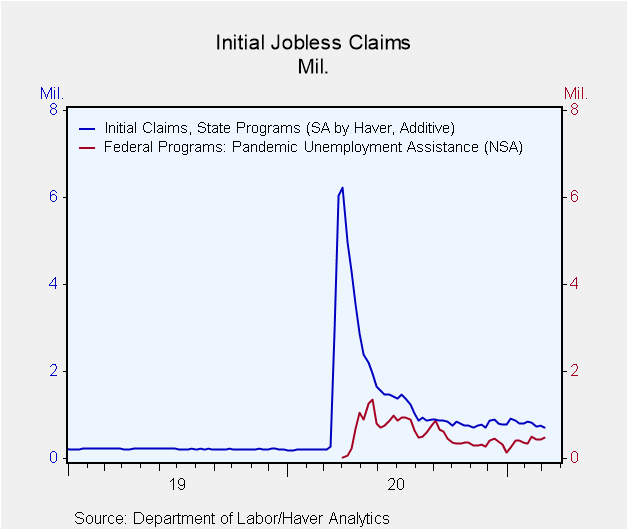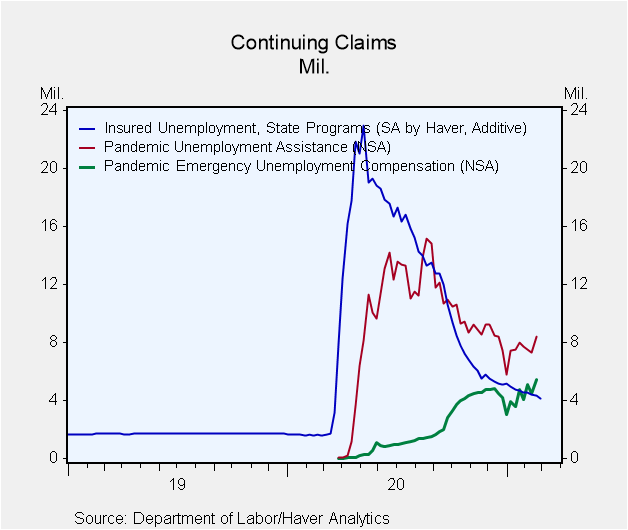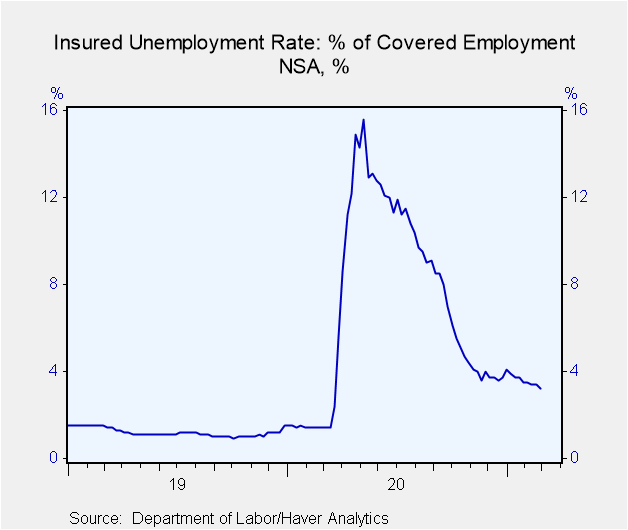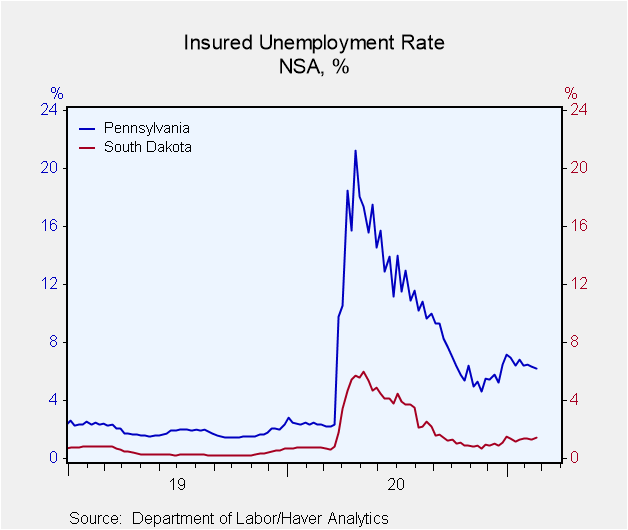 Global| Mar 11 2021
Global| Mar 11 2021U.S. Initial Unemployment Insurance Claims Decline Sharply
by:Tom Moeller
|in:Economy in Brief
Summary
• Initial claims fall to lowest level in four months. • Continuing claims also post sharp decline. • Insured jobless rate drops again. The job market continues to exhibit signs of healing. Initial claims for unemployment insurance [...]
• Initial claims fall to lowest level in four months.
• Continuing claims also post sharp decline.
• Insured jobless rate drops again.
The job market continues to exhibit signs of healing. Initial claims for unemployment insurance fell sharply to 712,000 during the week ended March 6 from 754,000 during the prior week, revised from 736,000. It was the lowest level of initial claims since the first week of November. The Action Economics Forecast Survey expected 725,000 initial claims for the latest week. The four-week moving average of initial claims declined to 759,000, the lowest level in roughly three months.
Initial claims for the federal Pandemic Unemployment Assistance (PUA) program rose to 478,001 last week from 436,138 one week earlier. These claims have risen from a low of 141,741 in early-January. The PUA program covers individuals such as the self-employed who are not included in regular state unemployment insurance. Given the brief history of this program, which started April 4, 2020, these and other COVID-related series are not seasonally adjusted.
Continuing claims for regular state unemployment insurance fell to 4.144 million in the week ended February 27 from an unrevised 4.337 million in the prior week. Continuing PUA claims for the week of February 20 rose to 8.387 million from a little-revised 7.329 million in the prior week. The number of Pandemic Emergency Unemployment Compensation (PEUC) claims also increased in that week to a record 5.455 million. The program covers people who were unemployed before COVID but exhausted their state benefits and are now eligible to receive benefits through March 14, 2021.
The total number of all state, federal and PUA and PEUC continuing claims edged higher to 20.116 million in the February 20 week, the highest level since the first week of December, up from a low of 16.106 million in the first week of January. This grand total is not seasonally adjusted.
The seasonally adjusted state insured rate of unemployment fell to 2.9% in the week ended February 27. It was the lowest level since the third week of March 2020 and down from a 17.1% high in the second week of May.
The state insured rates of unemployment continued to show wide variation. In the week ended February 27, the lowest rates were in Alabama (1.00%), Utah (1.08%), South Dakota (1.45%), North Carolina (1.46) and Tennessee (1.77%). The highest rates were in Rhode Island (4.88%), New York (4.93%), Connecticut (5.37%), Nevada (5.47%) and Pennsylvania (6.17%). These state rates are not seasonally adjusted.
As we continue to point out, the Labor Department changed its seasonal adjustment methodology back in August from multiplicative to additive. They did not restate the earlier data, so there is a break in the series in late August. Though the current comparison to early September is valid, comparisons with figures before August 22 are not. Haver Analytics has calculated methodologically consistent seasonally adjusted claims series dating back to 1979. This series matches the Department of Labor seasonally adjusted series since their change in methodology. For more details, please see the September 3 commentary on jobless claims.
Data on weekly unemployment claims going back to 1967 are contained in Haver's WEEKLY database, and they are summarized monthly in USECON. Data for individual states are in REGIONW. The expectations figure is from the Action Economics Forecast Survey, carried in the AS1REPNA database.
| Unemployment Insurance (SA, 000s) | 03/06/21 | 02/27/21 | 02/20/21 | Y/Y % | 2020 | 2019 | 2018 |
|---|---|---|---|---|---|---|---|
| Initial Claims | 712 | 754 | 736 | 237 | 1,450 | 218 | 221 |
| Initial Claims (NSA) | 709 | 757 | 717 | 254 | 1,367 | 218 | 221 |
| Initial Claims Pandemic Unemployment Assistance (NSA) | 478 | 436 | 427 | -- | -- | -- | -- |
| Continuing Claims | -- | 4,144 | 4,337 | 144 | 10,664 | 1,701 | 1,756 |
| Continuing Claims (NSA) | -- | 4,585 | 4,848 | 123 | 10,358 | 1,704 | 1,763 |
| Continuing Claims Pandemic Unemployment Assistance (NSA) | -- | -- | 8,387 | -- | -- | -- | -- |
| Insured Unemployment Rate (%) | -- | 2.9 | 3.1 |
1.2 |
7.3 | 1.2 | 1.2 |
Tom Moeller
AuthorMore in Author Profile »Prior to joining Haver Analytics in 2000, Mr. Moeller worked as the Economist at Chancellor Capital Management from 1985 to 1999. There, he developed comprehensive economic forecasts and interpreted economic data for equity and fixed income portfolio managers. Also at Chancellor, Mr. Moeller worked as an equity analyst and was responsible for researching and rating companies in the economically sensitive automobile and housing industries for investment in Chancellor’s equity portfolio. Prior to joining Chancellor, Mr. Moeller was an Economist at Citibank from 1979 to 1984. He also analyzed pricing behavior in the metals industry for the Council on Wage and Price Stability in Washington, D.C. In 1999, Mr. Moeller received the award for most accurate forecast from the Forecasters' Club of New York. From 1990 to 1992 he was President of the New York Association for Business Economists. Mr. Moeller earned an M.B.A. in Finance from Fordham University, where he graduated in 1987. He holds a Bachelor of Arts in Economics from George Washington University.










